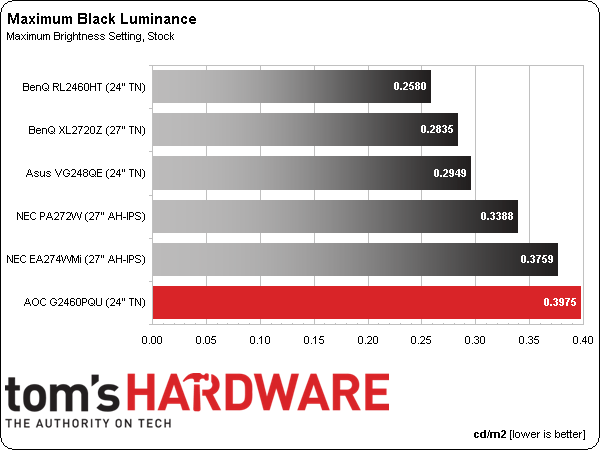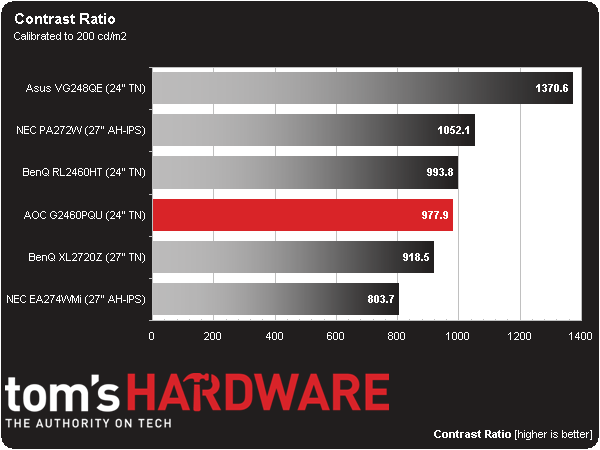AOC G2460PQU 24-inch 144 Hz Gaming Monitor Review
Not many monitors can run at 144 Hz, but AOC is adding to your list of choices with its G2460PQU 24-inch TN-based screen. We’ve already tested similar displays from Asus and BenQ. Can AOC match their speed and performance at a roughly $250 price point?
Why you can trust Tom's Hardware
Results: Brightness And Contrast
Uncalibrated
Before calibrating any panel, we measure zero and 100-percent signals at both ends of the brightness control range. This shows us how contrast is affected at the extremes of a display's luminance capability. We do not increase the contrast control past the clipping point. While that would successfully increase a monitor’s light output, the brightest signal levels would not be visible, resulting in crushed highlight detail. Our numbers show the maximum light level possible with no clipping of the signal.
For the comparison group, we’re including the 144 Hz Asus VG248QE and BenQ XL2720Z, plus a 60Hz BenQ RL2460HT. Rounding out the group are our recently-reviewed QHD professional screens from NEC.
The G2460PQU is the brightest monitor we’ve seen in a while. In fact, only Planar's PXL2790MW measures higher in our tests. It’s a shame there’s no backlight strobing feature available, because the extra output would likely combine to provide blur reduction and decent brightness.
A bright display often means higher black levels, though.
Sure enough, we measure a less-than-great black level result. But if you need to turn the backlight up all the way, it’s not a big deal. Why? Because as you’ll see below, this screen maintains solid contrast ratios at all light levels.
The max contrast result doesn’t suffer at all considering the G2460PQU’s prodigious output.
Any contrast ratio over 1000 to 1 is good. Even with an elevated black level, the image still has plenty of depth and detail. You’d have to be sitting in a brightly-lit room or outside to really need this much brightness, though it's good to know the option is available.
Get Tom's Hardware's best news and in-depth reviews, straight to your inbox.
We believe 50 cd/m2 is a practical minimum standard for screen brightness. Any lower and you risk eyestrain and fatigue. The G2460PQU bottoms out at 91.5339 cd/m2. For our taste, that's a little high if you're gaming in a dark room. A small amount of ambient light helps offset the effect, though.
Even though AOC finishes last in our comparison group, .0866 cd/m2 is still a decent black level result. The other screens have much lower white levels when their backlights are at the minimum, which accounts for their superior black levels. The exception is Asus' VG248QE. That display has almost freakishly-high contrast.
The G2460PQU maintains its contrast result of over 1000 to 1. While the Asus is another universe at over 6500 to 1, it’s not consistent at different backlight settings like the other displays are. I prefer monitors to not have a sweet spot for contrast. Rather, I like to see the same contrast performance at all backlight settings.
After Calibration
Since we consider 200 cd/m2 to be an ideal point for peak output, we calibrate all of our test monitors to that value. In a room with some ambient light (like an office), this brightness level provides a sharp, punchy image with maximum detail and minimum eye fatigue. On many monitors it’s also the sweet spot for gamma and grayscale tracking, which we'll look at on the next page. In a darkened room, many professionals prefer a 120 cd/m2 calibration. We have found it makes little to no difference on the calibrated black level and contrast measurements, though.
The G2460PQU’s black levels don’t suffer after calibration like some displays do. We didn’t have to make any large adjustments to the RGB sliders or the contrast control, so excellent contrast can be maintained without sacrificing color accuracy.
The corresponding reduction in contrast is very minor.
Sometimes you're forced to choose between high contrast or better color accuracy. That’s not the case with the G2460PQU. It only loses eight percent in the final contrast ratio measurement. We doubt anyone will notice.
ANSI Contrast Ratio
Another important measure of contrast is ANSI. To perform this test, a checkerboard pattern of sixteen zero and 100-percent squares is measured. The test is somewhat more real-world than on/off measurements because it gauges a display’s ability to simultaneously maintain both low black and full white levels, and factors in screen uniformity. The average of the eight full-white measurements is divided by the average of the eight full-black measurements to arrive at the ANSI result.
The G2460PUQ’s ANSI contrast stays solid at 953.9 to 1. That’s only a two-percent drop from the uncalibrated, full-brightness result. There is absolutely no penalty for calibrating this display, and you can set the backlight at any level to enjoy consistently excellent image depth.
Current page: Results: Brightness And Contrast
Prev Page Measurement And Calibration Methodology: How We Test Next Page Results: Grayscale Tracking And Gamma Response
Christian Eberle is a Contributing Editor for Tom's Hardware US. He's a veteran reviewer of A/V equipment, specializing in monitors. Christian began his obsession with tech when he built his first PC in 1991, a 286 running DOS 3.0 at a blazing 12MHz. In 2006, he undertook training from the Imaging Science Foundation in video calibration and testing and thus started a passion for precise imaging that persists to this day. He is also a professional musician with a degree from the New England Conservatory as a classical bassoonist which he used to good effect as a performer with the West Point Army Band from 1987 to 2013. He enjoys watching movies and listening to high-end audio in his custom-built home theater and can be seen riding trails near his home on a race-ready ICE VTX recumbent trike. Christian enjoys the endless summer in Florida where he lives with his wife and Chihuahua and plays with orchestras around the state.
-
PandaV4 I have a AOC G2460P monitor myself, and a unpleasant surprise was that refresh rate of 144 Hz wasn't supported if using the DisplayPort connection. Does G2460PQU have the same limitations, or does it actually support 144 Hz over DisplayPort?Reply -
PandaV4 After some googling it seems that G2460PQU and G2460P is the same model. So beware if you want to use Displayport you wont be able to use the 144 Hz setting too! And this doesn't have any blur reduction either! It seems there is actually a new updated model to be released this month the AOC G2460PG. And it has nvidia g-sync support and blur reduction, and supports 144 over dIsplayport.Reply
TL;DR: G2460PQU = DO NOT BUY, G2460PG = BUY. -
ceberle Reply13687399 said:I have a AOC G2460P monitor myself, and a unpleasant surprise was that refresh rate of 144 Hz wasn't supported if using the DisplayPort connection. Does G2460PQU have the same limitations, or does it actually support 144 Hz over DisplayPort?
The PQU does accept 144 Hz over DisplayPort.
-Christian- -
PandaV4 Reply
A bit of googling brought up this article - http://pcmonitors.info/reviews/aoc-g2460pqu which says: " The image provided by DisplayPort is very similar on this monitor and it should also support the maximum (144Hz) refresh rate. Unfortunately that was not the case during our testing" and "The PC resolutions below this should feature 1920 x 1080 with 100Hz, 120Hz and 144Hz selectable – but that isn’t the case.". It seems there are different revisions of this monitor with the same model number. So if you buy one of those than you are practically gambling about the 144 Hz support.13688062 said:13687399 said:I have a AOC G2460P monitor myself, and a unpleasant surprise was that refresh rate of 144 Hz wasn't supported if using the DisplayPort connection. Does G2460PQU have the same limitations, or does it actually support 144 Hz over DisplayPort?
The PQU does accept 144 Hz over DisplayPort.
-Christian-
-
npyrhone Will we ever see here a review of even one non-TN gaming monitor? The reduced color depth renders to image quality absolutely disgusting.Reply
I will be the first one to congratulate you when you publish the next review of a monitor with a non-TN panel working over 60Hz. -
3Dns I have that model too and i buy it after a HP 23xi IPS LED Panel.Reply
I understand that.
It doesnt worth 300€ for this model. All you need is 60hz and 24" Panel that you can take it with 120€. For me IPS Panels offer you way better colors so for me its better. Now if you want it for a GTX780 and above and you wanna play over 60FPS it may worth.
But have in mind that a normal monitor cost ~120$ and this model cost double. You can spend that money in other hardware areas like better GPU for example. -
Adroid Sorry, but I won't ever buy another 1080p "gaming" display. 1920x1200 is vastly superior for "gaming" screens, and it's a shame the industry has veered away from it.Reply
I guess the thought process involves "and you can watch HD movies on it". Needless to say the 16:9 ratio is cheaper for manufacturers, and it's a great sales pitch. Well, give me a break. I got suckered into that line of thinking and I probably watched 2-3 movies on my "gaming" 23 inch monitor in 4-5 years.
Let's keep the movies where they belong in the living room and re-focus "gaming" screens where they should have never left - in the 16:10 aspect ratio. -
alchemy69 If a game isn't enjoyable at 60Hz it isn't going to be enjoyable at 144Hz. And if it is enjoyable at 144, it still will be at 60. I've had some of the greatest fun over the last 30 years playing on tiny monitors, at low resolution and probably less than 30fps. I don't need the industry telling me what I need to have fun just so they can move more product.Reply










